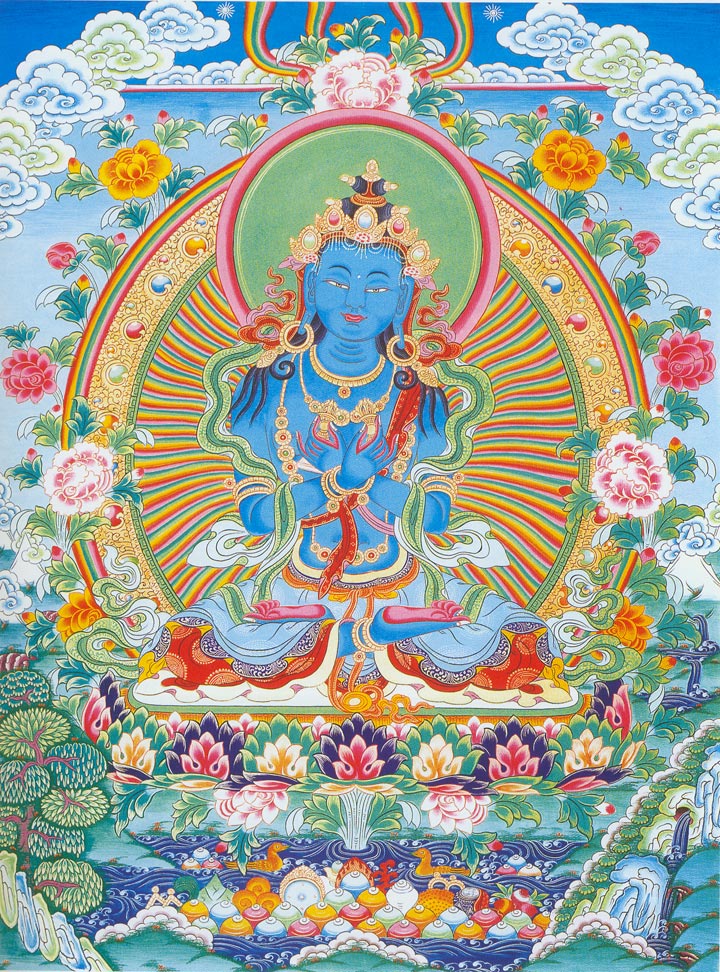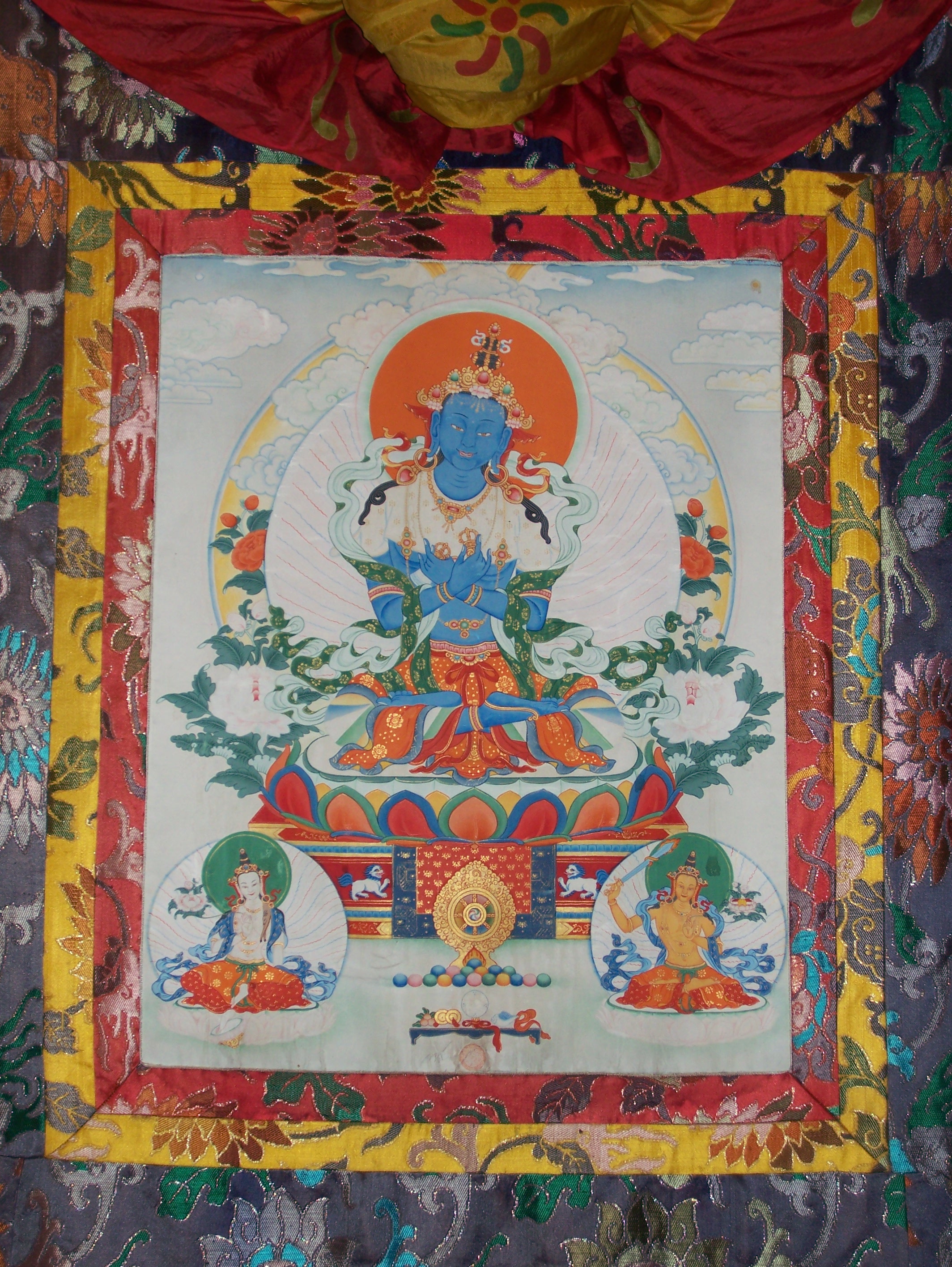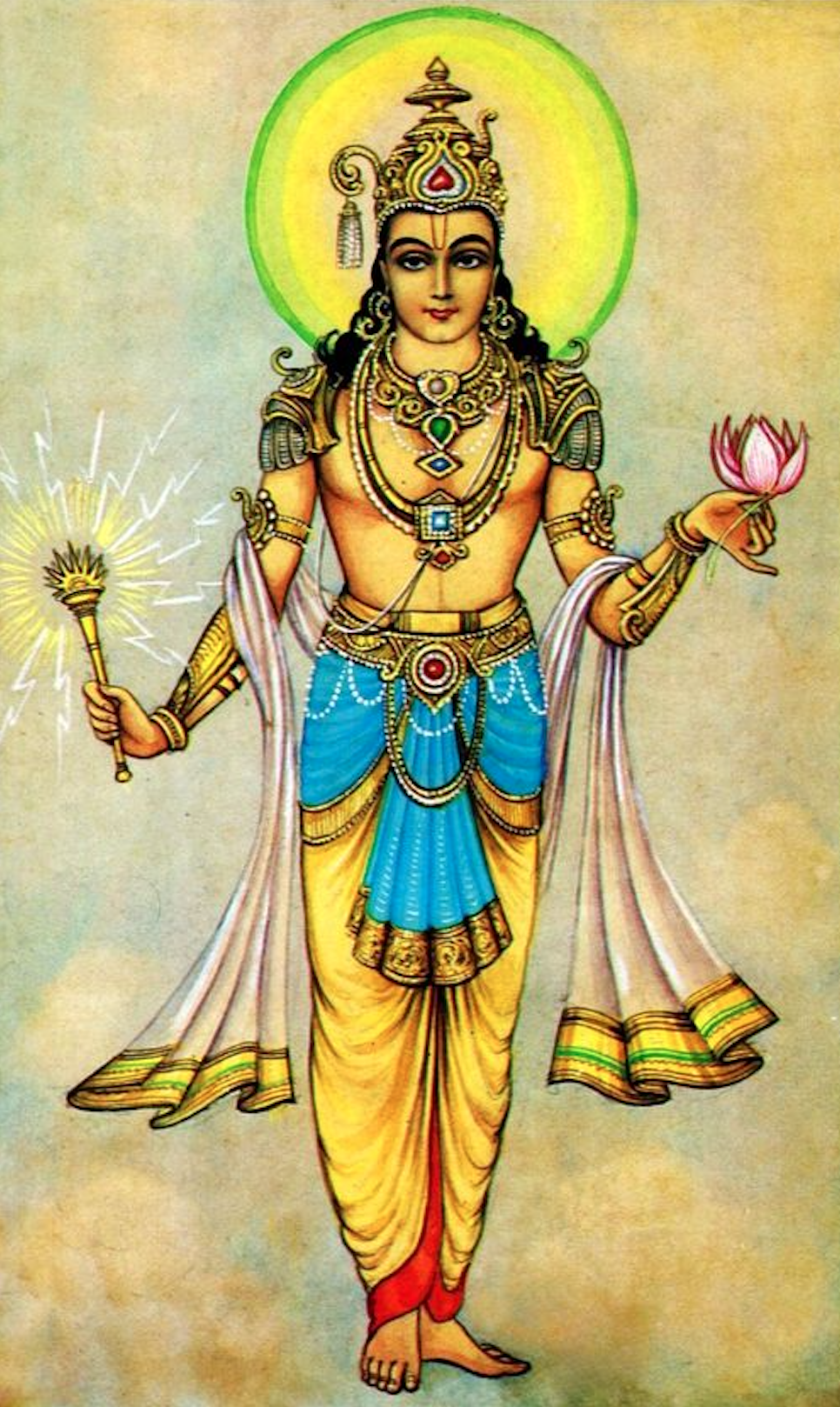|
Adibuddha
In Vajrayana Buddhism, the Ādi-Buddha () is the "First Buddha" or the "Primordial Buddha". Another common term for this figure is Dharmakāya Buddha. The term emerges in tantric Buddhist literature, most prominently in the Kalachakra.Buswell, Robert E.; Lopez, Jr., Donald S. (2013). ''The Princeton dictionary of Buddhism''. Princeton: Princeton University Press. . Entry on "ādibuddha". "Ādi" means "first", such that the Ādibuddha was the first to attain Buddhahood. "Ādi" can also mean "primordial", not referring to a person but to an innate wisdom that is present in all sentient beings. In Indo-Tibetan Buddhism In Indo-Tibetan Buddhism, the term Ādibuddha is often used to describe the Buddha Samantabhadra (in Nyingma), Vajradhara or Kalachakra (in the Sarma schools).Wayman, Alex; The Buddhist Tantras: Light on Indo-Tibetan esotericism, page 53. There was also a tradition in India which saw Mañjuśrī as the Ādibuddha, as exemplified by Vilāsavajra's commentary to t ... [...More Info...] [...Related Items...] OR: [Wikipedia] [Google] [Baidu] |
Kalachakra
''Kālacakra'' () is a polysemic term in Vajrayana Buddhism that means "wheel of time" or "time cycles". "''Kālacakra''" is also the name of a series of Buddhist texts and a major practice lineage in Indian Buddhism and Tibetan Buddhism. The tantra is considered to belong to the unexcelled yoga ('' anuttara-yoga'') class. Kālacakra also refers both to a patron tantric deity or yidam in Vajrayana and to the philosophies and yogas of the Kālacakra tradition. The tradition's origins are in India and its most active later history and presence has been in Tibet. The tradition contains teachings on cosmology, theology, philosophy, sociology, soteriology, myth, prophecy, medicine and yoga. It depicts a mythic reality whereby cosmic and socio-historical events correspond to processes in the bodies of individuals. These teachings are meant to lead to a transformation of one's body and mind into perfect Buddhahood through various yogic methods. The Kālacakra tradition is based on Mah ... [...More Info...] [...Related Items...] OR: [Wikipedia] [Google] [Baidu] |
Kulayarāja Tantra
The ''Kulayarāja Tantra'' (Tibetan phonetically: ''Kunjed Gyalpo'', ; "All-Creating King", "Supreme Source") is a Buddhist Tantra in the Tibetan language and the principal 'mind-series' (Wylie: ''sems sde'') text of the Dzogchen tradition. The ''Kunjed Gyalpo'' is framed as a teaching by the first Buddha, Samantabhadra to Vajrasattva. Samantabhadra is presented as the personification of '' bodhi-citta'', the Awakened Mind, the "mind of perfect purity" or "pure perfect presence". The colophon of the text mentions that it was explained by the Indian Śrī Siṃha and translated by Vairotsana. According to the Tibetologist David Germano, the ''Kunjed Gyalpo'' "is the main canonical work of the Great Perfection as it emerges from the "dark period" (850 to 1000 C. E.) into the light of the economic and religious transformations of the eleventh century. While the dark period was marked by economic depression, political decentralization, and a paucity of historical records, it ... [...More Info...] [...Related Items...] OR: [Wikipedia] [Google] [Baidu] |
Vajradhara
Vajradhara (Sanskrit: वज्रधर. (Also, the name of Indra, because 'Vajra' means diamond, as well as the thunderbolt, anything hard more generally) Tibetan: རྡོ་རྗེ་འཆང། rdo rje 'chang (Dorje Chang); zh, t=金剛總持, p=Jīngāng zǒng chí; Javanese: Kabajradharan; Japanese: 持金剛仏; English: Diamond-holder; Vietnamese: Kim Cang Tổng Trì) is the ultimate primordial Buddha, or Adi-Buddha, according to the Sakya, Gelug and Kagyu schools of Tibetan Buddhism. In the evolution of Indian Buddhism, Buddha Vajradhara gradually displaced Samantabhadra, who is the 'Primordial Buddha' in the Nyingma, or 'Ancient School.' However, the two are metaphysically equivalent. Achieving the 'state of Vajradhara' is synonymous with complete realisation. According to the Kagyu lineage, Buddhā Vajradhara is the primordial Buddha, the Dharmakaya Buddha. He is depicted as dark blue in color, expressing the quintessence of buddhahood itself and representing ... [...More Info...] [...Related Items...] OR: [Wikipedia] [Google] [Baidu] |
Buddhahood
In Buddhism, Buddha (; Pali, Sanskrit: 𑀩𑀼𑀤𑁆𑀥, बुद्ध), "awakened one", is a title for those who are awake, and have attained nirvana and Buddhahood through their own efforts and insight, without a teacher to point out the dharma (Sanskrit 𑀥𑀭𑁆𑀫; Pali ''dhamma''; "right way of living"). The title is most commonly used for Gautama Buddha, the founder of Buddhism, who is often simply known as "the Buddha". Buddhahood ( sa, 𑀩𑀼𑀤𑁆𑀥𑀢𑁆𑀯, buddhatva; pi, buddhatta or ; ) is the condition and rank of a buddha "awakened one". This highest spiritual state of being is also termed ''sammā-sambodhi'' (skt. samyaksaṃbodhi 'full complete awakening'). The title is also used for other beings who have achieved ''bodhi'' (awakening) and ''moksha'' (release from craving), such as the other human Buddhas who achieved enlightenment before Gautama, the five celestial Buddhas worshiped primarily in Mahayana, and the bodhisattva named M ... [...More Info...] [...Related Items...] OR: [Wikipedia] [Google] [Baidu] |
Trikaya
The Trikāya doctrine ( sa, त्रिकाय, lit. "three bodies"; , ) is a Mahayana Buddhist teaching on both the nature of reality and the nature of Buddhahood. The doctrine says that Buddha has three ''kāyas'' or ''bodies'', the ''Dharmakāya'' (ultimate reality), the ''Saṃbhogakāya'' (divine incarnation of Buddha), and the ''Nirmāṇakāya'' (physical incarnation of Buddha). Definition The doctrine says that a Buddha has three ''kāyas'' or bodies: # The ''Dharmakāya'', "Dharma body," ultimate reality, "pure being itself," Buddha nature, emptiness, it is usually associated with Vairocana; # The ''Saṃbhogakāya'', "Enjoyment (or Bliss) body," the divine Buddhas of the Buddha realms, it is usually associated with Amitabha; # The ''Nirmāṇakāya'', "Transformation (or Appearance) Body," physical appearance in the world, it is usually associated with Gautama. Origins The Dharmakāya doctrine was possibly first expounded in the ''Aṣṭasāhasrikā Prajñāpār ... [...More Info...] [...Related Items...] OR: [Wikipedia] [Google] [Baidu] |
14th Dalai Lama
The 14th Dalai Lama (spiritual name Jetsun Jamphel Ngawang Lobsang Yeshe Tenzin Gyatso, known as Tenzin Gyatso (Tibetan: བསྟན་འཛིན་རྒྱ་མཚོ་, Wylie: ''bsTan-'dzin rgya-mtsho''); né Lhamo Thondup), known as Gyalwa Rinpoche to the Tibetan people, is the current Dalai Lama. He is the highest spiritual leader and former head of the country of Tibet. He was born on 6 July 1935, or in the Tibetan calendar, in the Wood-Pig Year, 5th month, 5th day. He is considered a living Bodhisattva, specifically, an emanation of Avalokiteśvara in Sanskrit and Chenrezig in Tibetan. He is also the leader and a monk of the Gelug school, the newest school of Tibetan Buddhism, formally headed by the Ganden Tripa. The central government of Tibet, the Ganden Phodrang, invested the Dalai Lama with temporal duties until his exile in 1959. The 14th Dalai Lama was born to a farming family in Taktser (Hongya Village), in the traditional Tibetan region of Amdo (administra ... [...More Info...] [...Related Items...] OR: [Wikipedia] [Google] [Baidu] |
Je Tsongkhapa
Tsongkhapa ('','' meaning: "the man from Tsongkha" or "the Man from Onion Valley", c. 1357–1419) was an influential Tibetan Buddhist monk, philosopher and tantric yogi, whose activities led to the formation of the Gelug school of Tibetan Buddhism.Tsong khapa (2006), pp. ix-x. He is also known by his ordained name Losang Drakpa (, Skt. Sumatikīrti) or simply as "Je Rinpoche" (, "Precious Lord"). He is also known by Chinese as Zongkapa Lobsang Zhaba or just Zōngkàbā (宗喀巴). Tsongkhapa was born in Amdo, the son of a Tibetan Longben Tribal leader who also once served as an official of the Yuan Dynasty. As a monk, he studied under numerous teachers of the various Tibetan Buddhist traditions which flourished in central Tibet, including Sakya, Jonang, Kagyu and Kadam. Tsongkhapa was a prolific author with a broad knowledge of Buddhist philosophy, logic, hermeneutics and practice. He wrote numerous works on madhyamaka philosophy (such as ''Ocean of Reasoning,'' a comment ... [...More Info...] [...Related Items...] OR: [Wikipedia] [Google] [Baidu] |
Alex Wayman
Alex Wayman (January 11, 1921 – September 22, 2004) was a Tibetologist and Indologist and worked as a professor of Sanskrit at Columbia University. He was of Jewish background.Amanda Porterfield, ''The Transformation of American Religion : The Story of a Late-Twentieth-Century Awakening'', Oxford University Press (2001), p. 159 After finishing his B.A. (1948), M.A. (1949) and Ph. D. (1959) at the University of California, Los Angeles he came to Columbia as a visiting professor in 1966. In 1967 he was made professor of Sanskrit and remained in this position until his retirement in 1991. Wayman wrote many books on Buddhism, especially Tantric Buddhist themes, and on Buddhist logic Buddhist logico-epistemology is a term used in Western scholarship for '' pramāṇa-vāda'' (doctrine of proof) and ''Hetu-vidya'' (science of causes). Pramāṇa-vāda is an epistemological study of the nature of knowledge; Hetu-vidya is a syst .... References * Columbia NewsAlex Wayman, Pioneer of ... [...More Info...] [...Related Items...] OR: [Wikipedia] [Google] [Baidu] |
Namkhai Norbu
Namkhai Norbu (; 8 December 1938 – 27 September 2018) was a Tibetan Buddhist master of Dzogchen and a professor of Tibetan and Mongolian language and literature at Naples Eastern University. He was a leading authority on Tibetan culture, particularly in the fields of history, literature, traditional religions (Tibetan Buddhism and Bon), and Traditional Tibetan medicine, having written numerous books and scholarly articles on these subjects. When he was two years old, Norbu was recognized as the 'mindstream emanation', a tulku, of the Dzogchen teacher Adzom Drugpa (1842–1924). At five, he was also recognized as a mindstream emanation of an emanation of Shabdrung Ngawang Namgyel (1594–1651). At the age of sixteen, he met master Rigdzin Changchub Dorje (1863–1963), who became his main Dzogchen teacher. In 1960, he went to Italy at the invitation of Giuseppe Tucci and served as Professor of Tibetan and Mongolian Language and Literature from 1964 to 1992 at Naples Eastern ... [...More Info...] [...Related Items...] OR: [Wikipedia] [Google] [Baidu] |
Vajra
The Vajra () is a legendary and ritual weapon, symbolising the properties of a diamond (indestructibility) and a thunderbolt (irresistible force). The vajra is a type of club with a ribbed spherical head. The ribs may meet in a ball-shaped top, or they may be separate and end in sharp points with which to stab. The vajra is the weapon of Indra, the Vedic king of the devas and heaven. It is used symbolically by the dharmic traditions of Hinduism, Buddhism, and Jainism, often to represent firmness of spirit and spiritual power. According to Hinduism, the vajra is considered one of the most powerful weapons in the universe. The use of the vajra as a symbolic and ritual tool spread from Hinduism to other religions in India and other parts of Asia. Etymology According to Asko Parpola, the Sanskrit () and Avestan both refer to a weapon of the Godhead, and are possibly from the Proto-Indo-European root ''*weg'-'' which means "to be(come) powerful". It is related to Proto- ... [...More Info...] [...Related Items...] OR: [Wikipedia] [Google] [Baidu] |
Ratnagotravibhāga
The ''Ratnagotravibhāga'' (Sanskrit, abbreviated as RGV, meaning: ''Analysis of the Jeweled Lineage, Investigating the Jewel Disposition'') and its ''vyākhyā'' commentary (abbreviated RGVV to refer to the RGV verses along with the embedded commentary), is an influential Mahayana, Mahāyāna Buddhist treatise on buddha-nature (a.k.a. tathāgatagarbha). The text is also known as the ''Mahāyānottaratantraśāstra (The Ultimate Teaching of the Mahāyāna).''Gardner, Alex. "On the ''Ratnagotravibhāga''." ''Buddha-Nature: A Tsadra Foundation Initiative'', September 12, 2018. https://buddhanature.tsadra.org/index.php/Articles/On_the_Ratnagotravibh%C4%81ga. The RGVV was originally composed in Sanskrit, likely between the middle of the third century and no later than 433 CE.Takasaki (1966), The text and its commentary are also preserved in Tibetan and Chinese translations''.'' The ''Ratnagotra'' focuses on the buddha nature present in all sentient beings, which is eternal, blissfu ... [...More Info...] [...Related Items...] OR: [Wikipedia] [Google] [Baidu] |
Buddha-nature
Buddha-nature refers to several related Mahayana Buddhist terms, including '' tathata'' ("suchness") but most notably ''tathāgatagarbha'' and ''buddhadhātu''. ''Tathāgatagarbha'' means "the womb" or "embryo" (''garbha'') of the "thus-gone" (''tathāgata''), or "containing a ''tathāgata''", while ''buddhadhātu'' literally means "Buddha-realm" or "Buddha-substrate". Buddha-nature has a wide range of (sometimes conflicting) meanings in Indian and later East Asian and Tibetan Buddhist literature. Broadly speaking, the terms refer to the potential for all sentient beings to be a Buddha, since the luminous mind, "the natural and true state of the mind," the pure (''visuddhi'') mind undefiled by kleshas, is inherently present in every sentient being. It will shine forth when it is cleansed of the defilements, c.q. when the nature of mind is recognised for what it is. The ''Mahāyāna Mahāparinirvāṇa Sūtra'' (written 2nd century CE), which was very influential in the Ch ... [...More Info...] [...Related Items...] OR: [Wikipedia] [Google] [Baidu] |




.jpeg/1200px-Gandhara_Buddha_(tnm).jpeg)


.jpg)

